Posts Tagged ‘questions for your vet’
Cat Safety Tips: How to Protect Your Furry Companion
 Many of us have those 4-legged feline friends that love to hunt and no amount of domestication has changed their inherent desire to patrol their domain in the hunt for prey. We have all seen the look of pure joy on our cat’s faces when they watch birds and small rodents from the window. And because cats are naturally curious, they love to explore. That is why some people allow their cats to spend considerable time outdoors. The downside it that the outdoors has many dangers that can linger and it is our job as responsible owners to keep them safe.
Many of us have those 4-legged feline friends that love to hunt and no amount of domestication has changed their inherent desire to patrol their domain in the hunt for prey. We have all seen the look of pure joy on our cat’s faces when they watch birds and small rodents from the window. And because cats are naturally curious, they love to explore. That is why some people allow their cats to spend considerable time outdoors. The downside it that the outdoors has many dangers that can linger and it is our job as responsible owners to keep them safe.
While most experts would recommend that the best thing to do would be keeping them indoors, you can allow them to get some fresh air in a relative safe environment away from predators that would prey on your cat and making sure that they are protected when they go outside.
Some owners may try to leash train their cat. This is one of the easiest means of monitoring where your cat goes because you get to go along for the walk. Cat’s generally dislike harnesses, so they will need to be made accustom to using them first. This may entail having the harness on inside and provide positive reinforcement with treats. Supervised outdoor time is a great way to bond with your cat and give her the mental stimulation that her wild instincts crave.
Whether you allow her to roam free or keep her as close as possible, it is important for the cat to either have a microchip or some other form of identification on your pet. If you use a collar, a safety collar with an elastic panel will allow your pet to break free if it gets caught.
To allow cats to have the ability to go outside, some owners make a catio that keep predators out and their pet in. This can serve as an outdoor playground within the vicinity of your home. You can feel safe knowing where it is and that she is not running out into the street or being picked up by predator birds or other mammls.
If your cat goes outdoors, it is at risk to the diseases and parasites that the outdoor feral cats have. So it is important to have your pet’s vaccines updated and kept on flea and tick control.
Your back yard can be dangerous to your pet if you have planted some toxic plants for landscaping. Plants like lillies may look nice in your back yard, but they can be toxic to your pet. It is important to make sure that anything potentially toxic and dangerous be picked up and secured. I would also recommend not having mouse poisons available because not only would the poison be toxic, eating a dead mouse that has succumbed to the poison may be also lethal to the cat.
It is important to have a regular dinner time. That way when the cat’s return for it evening meal, they will be able to be locked up for the evening. This will protect her from the nightly predators and allow her to go on daily patrol the next morning.
For any more questions on cats, or any other furry companion, contact our offices today!
New Puppy Checklist: Everything You Need Before Welcoming Your New Furry Friend into Your Life
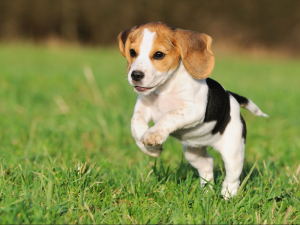 Bringing a new puppy into your home is an exciting time but requires some preparation for your home. Puppies require a lot of attention and care, so this checklist will be beneficial if you are unsure where to start with the basics for your new puppy.
Bringing a new puppy into your home is an exciting time but requires some preparation for your home. Puppies require a lot of attention and care, so this checklist will be beneficial if you are unsure where to start with the basics for your new puppy.
Some companies have created puppy starter kits. For example, this box made by Chewy has a set of toys, treats, and potty-training materials to help you with your new puppy. All top-rated items, new puppy owners are sure to appreciate it. It also makes a great gift. It can be found here.
Beyond toys, treats, and potty-training materials, puppies need food and water bowls. There are a lot of different options, but one that is slightly lifted is easier for your puppy to eat from. If you get one with walls, it is more likely your floor will stay cleaner.
Also necessary is a bed for your pet. An elevated bed is good for keeping your dog lifted and is helpful for teaching different cues. Other more traditional options are great too, especially as your pups are growing quickly.
Some owners choose to crate their puppies, and there are a lot of options but must be replaced as dogs grow. Crates help dogs have a safe place, especially as they adjust to a new space and lifestyle.
Also important for your new puppy is a leash. There are many kinds of leashes, with different uses. It will most likely be trial and error to find what works for you and your puppy, so be prepared for a trial period.
Puppies require hygiene efforts. This includes toothbrushes, toothpaste, nail clippers, brushes, and bathing supplies. Providing exposure to these items while young makes it less scary for adult dogs and easier for their owners.
Lastly, a collar is a great way to express your and your pet’s personality. Be prepared for your new pup with a collar and tag to provide some protection and peace of mind.
The last step for a new puppy is establishing an appointment with your veterinarian to get started on vaccinations and discuss your new dog’s life! Feel free to contact Dr. Olsen of Olsen Veterinary Clinic at 618-656-5868 to set up an appointment or discuss any questions!
2022 Pet Gift Guide
 Don’t leave your pet out of the holiday fun! Furry friends like to open gifts too! Here are a few options to show your four-legged pal some love.
Don’t leave your pet out of the holiday fun! Furry friends like to open gifts too! Here are a few options to show your four-legged pal some love.
The Pupsicle is a great opportunity to give your dog a new treat experience. You freeze your dog’s favorite food in the mold, then when it is time for a treat, you put the frozen treat in the Pupsicle. When they’re done, you’re able to open the ball, wash it, and repeat! Find it here.
You can liven up your cat’s drinking experience with a cat fountain. Some cats enjoy moving water more than still, and a plastic cat fountain such as this one here circulates water for cats to drink.
Say you want to get a gift for your favorite pet owner in your life. The company West and Willow makes custom pet portraits that any pet owner will be sure to love. You can find them linked here.
Social media has allowed several pets to become Tik Tok famous. Pets have been trained to use buttons programmed with specific words to communicate with their owners. You can find a starter kit here to try your pet’s hand at internet fame.
For cats that love to play but whose owners don’t love obnoxiously bright-colored toys laying around the house, these handmade cat toys from an Etsy seller are stylish and aesthetically pleasing. They are environmentally friendly as well, made from leftover upholstery fabric. These toys are filled with grounds of a plant called silvervine which is like catnip. If your cat doesn’t really like regular catnip, silvervine is a great alternative. Find these toys here.
Whether you are looking for a gift for your furry friend or a close pet-lover, these gifts are sure to please all. Feel free to contact Dr. Olsen at Olsen Veterinary Clinic at 618-656-5868 with any questions!
Dr. Olsen’s Breed Spotlight: The Tibetan Mastiff

Tibetan Mastiff
The Tibetan Mastiff is a large-size Tibetan dog breed. It has a medium to long double coat and is found in many colors. These can be solid black, black and tan, various shades of red (from pale gold to deep red), and bluish gray. Sometimes, they can have white markings around their neck, chest, and legs.
The term mastiff goes back to when the Europeans first went to Tibet. They used the term to refer to nearly all large dog breeds in the West. Early Western visitors misnamed several of its breeds through this process. For example, the Tibetan terrier is not a terrier, and the Tibetan spaniel is not a spaniel.
In the early 20th century, the Prince of Wales, George, introduced a pair of Tibetan Mastiffs to the United Kingdom, which caused the breed to become prevalent enough in England to be shown at the Crystal Palace show in 1906. Since 1980, the breed has been gaining in popularity worldwide.
The Tibetan Mastiff is a primitive breed and retains the general hardiness that would be required of them to survive in the harsh environment of Tibet, Ladakh, and other high-altitude Himalayan regions. Because of this, they tend to have strong instinctive behavior, including canine pack behaviors. These help the breed survive in harsh environments. It has maintained many of the same biological processes as wolfs and other animals.
The dog has a long, double coat whose length depends ultimately on the climate. Uniquely, the Tibetan Mastiff lacks the unpleasant big-dog smell that affects many other large dog breeds. Their coat can shed dirt and odors on its own. Many of the dogs shed somewhat throughout the year, but there is generally one great molt in late Winter or early Spring.
Tibetan Mastiffs have a life expectancy of around 10-16 years, but this span can vary. Generally, the breed has fewer genetic health problems than many other breeds. However, cases can be found of hypothyroidism, entropion, ectropion, distichiasis, skin problems, etc. As with most large breeds, some will suffer from elbow or hip dysplasia.
Hypothyroidism is common in Tibetan Mastiffs, along with many other large “northern” breeds. They should be tested periodically throughout their lives using a complete thyroid panel. However, because the standard thyroid levels were established using domestic dog breeds, test results must be considered in the context of what is “normal” for the breed, not what is standard for all breeds. Many Tibetan Mastiffs will have “low” thyroid values, but no clinical symptoms. Vets and owners differ on the relative merits of medicating dogs that test “low” but are completely asymptomatic.
The Tibetan Mastiff is sure to be a large lovable friend for any owner. Feel free to contact Dr. Olsen at Olsen Veterinary Clinic with any questions at 618-656-5868.
Tips and Tricks For Grooming Your Pet
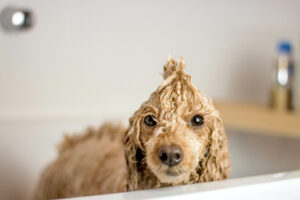
Part of taking care of your pet is regular grooming efforts to keep their coat healthy and your pet comfortable. These tips will help you stay on top of their grooming and keep your pet happy and healthy.
First, be sure to regularly brush your pet’s coat to prevent matting. Especially with long-haired animals. Your pet needs regular brushing regardless of the breed to keep its coat shiny and healthy. The amount of brushing depends on coat length and texture. Longhaired breeds will need more frequent brushing of at least once a week if not every other day. Short-haired breeds like greyhounds or Labradors may need a good brushing only every other week. Matting can cause pain for your pet. This will lead to licking or biting, causing skin irritation which can then lead to skin infections. Be sure to brush your pet regularly to keep their coat healthy.
Second, many pet owners choose to have a groomer take care of their pet’s hair care. That said, if you proceed carefully, you can trim overgrown hair around your pet’s eyes or pays in between professional grooming appointments. Trimming the hair around your pet’s eyes can prevent overgrown hair from blocking its vision and rubbing against and damaging its eyes. When trimming, make sure your pet is calm and lying down, preferably. Move slowly and calmly and use extra caution with scissors. Make sure to reward their calmness with a treat after they are finished.
Third, trimming your pet’s nails will keep them from experiencing discomfort from overly long nails. There are many different tools to do so, and you may have some trial and error until you find what works best. There are plenty of resources found online for guidance on your specific pet and how to trim its nails.
When grooming your pet, be sure to check their ears for ear infections. Ear infections can be painful, so if you notice any inflammation, odd smells, shaking or scratching, discharge, or pain upon touch. If you notice any of these signs during your regular grooming, take your pet to the vet for a checkup.
Grooming your pet is part of their regular care of them such as feeding them and providing them with exercise. With these tips, you can be more prepared for helping your pet take care of itself. Of course, with any questions, feel free to contact Dr. Olsen at Olsen Veterinary Clinic at 618-656-5868.
Tips for Finding a Missing Pet
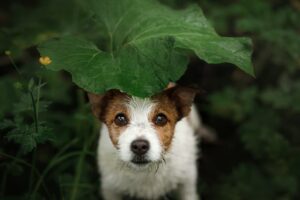 A missing furry friend can cause a lot of stress for you and your family. When your pet is missing, it is important to act fast. Don’t waste time waiting for your pet to come home. The sooner you begin to look for your pet, the better the odds are of you finding them.
A missing furry friend can cause a lot of stress for you and your family. When your pet is missing, it is important to act fast. Don’t waste time waiting for your pet to come home. The sooner you begin to look for your pet, the better the odds are of you finding them.
Start your search in your neighborhood or the area the pet was lost. Be sure to let your neighbors know that your pet is missing and ask them to keep an eye out for them.
Thoroughly search the area. Call your pet’s name and check any places where they could have become trapped, such as basements, garages, or under vehicles. A lost pet will often hide during the day, so be sure to go out again at night with a flashlight and call for them if you don’t have luck during the day.
Check with your local shelters daily. Do not just call; visit the shelters to look for your pet. Many animals are difficult to describe over the phone, and only you really know what your pet looks like.
Call all animal control agencies in your town and surrounding areas. Animal control officers work through the police department and pick up stray animals. Call them or check their shelters at least every two days.
Other community resources include local neighborhood groups on apps like Nextdoor or Facebook. Ask your friends and neighbors to share photos of your pet notifying their network that your pet is missing. You can also put up physical lost pet signs in your neighborhood, post offices, libraries, pet supply stores, veterinary offices, and grocery stores. Be sure to inform your veterinarian and groomer that your pet is lost in case they receive a call.
Lastly, there are online services like lostmydoggie.com and lostmykitty.com that after you fill out the information about the pet, will notify shelters, rescues, and vets in the area automatically, providing them with the information you supplied.
A lost pet is a scary time. However, a lost pet with a microchip and a pet ID tag is a lot more likely to find its way back home. A microchip is a permanent pet ID tag that allows for veterinarians and shelters to identify who owns that pet, even if the pet ID tag is missing.
If you have lost your pet, found a pet, or have any questions at all, feel free to call Dr. Olsen of Olsen Veterinary Clinic at 618-656-5868.
CBD For Your Dog: What You Need To Know
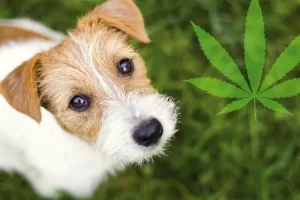 CBD can work wonders for dogs in oils or dog treats. CBD can provide the same benefits for dogs as medical marijuana for humans who experience seizures, extreme pain, anxiety, and cancer. CBD is not what you may traditionally view as weed. CBD is not psychoactive, unlike its more famous counterpart, THC (tetrahydrocannabinol). CBD is one of over 80 different chemical compounds called “cannabinoids” derived from the marijuana plant. Instead, CBD shares important metabolic pathways with a class of drugs called NSAIDs (non-steroidal anti-inflammatory drugs) like ibuprofen and Rimadyl. These pathways control many processes in the body, from inflammatory responses to blood clotting. Never give dogs straight marijuana or any product containing THC, the primary psychoactive component of marijuana. However, CBD-based products can substantially improve your dog’s quality of life when used in conjunction with other therapies.
CBD can work wonders for dogs in oils or dog treats. CBD can provide the same benefits for dogs as medical marijuana for humans who experience seizures, extreme pain, anxiety, and cancer. CBD is not what you may traditionally view as weed. CBD is not psychoactive, unlike its more famous counterpart, THC (tetrahydrocannabinol). CBD is one of over 80 different chemical compounds called “cannabinoids” derived from the marijuana plant. Instead, CBD shares important metabolic pathways with a class of drugs called NSAIDs (non-steroidal anti-inflammatory drugs) like ibuprofen and Rimadyl. These pathways control many processes in the body, from inflammatory responses to blood clotting. Never give dogs straight marijuana or any product containing THC, the primary psychoactive component of marijuana. However, CBD-based products can substantially improve your dog’s quality of life when used in conjunction with other therapies.
CBD can help with many ailments your dog may experience such as pain management, arthritis, anxiety, seizures, and even cancer. Because CBD shares the same metabolic pathways as anti-inflammatory drugs, it can help with inflammatory conditions. Anything that ends in “-itis” is an inflammatory condition. This includes osteoarthritis (arthritis for short). 25% of dogs will be diagnosed with arthritis in their lifetime. By some estimates, as many as 60% of dogs exhibit some degree of the disease. CBD can provide relief for dogs that may be experiencing pain.
With any treatment, there are potential risks. Overall, CBD itself seems to be incredibly safe for both dogs and cats. However, it has been found that when given at the recommended doses, CBD does cause an elevation in an important liver value on bloodwork called alkaline phosphatase (ALP). It is too early in its research to see if the elevation in this liver value has any medical significance. It could signify that CBD causes irritation or damage to the liver. Alternatively, it could be an artificial finding in which the drug interferes with the way the lab measures the liver value. It is simply too early to know for sure. There are anecdotal reports of dogs becoming somewhat sleepy or sedate if they receive a large dose of CBD, but these effects resolve independently with time. Moreover, CBD doesn’t appear to have any drug interactions when given to a dog on an anti-inflammatory drug like Rimadyl. However, there is a theoretical risk of drug interaction, as with any other medication, so it is essential to consult with your veterinarian before treating your dog with CBD.
CBD can be administered in topical treatments; however, it is most often administered orally to dogs. The correct dosage is imperative. Studies on using CBD for dogs with arthritis or seizures generally use a dose between 2-8 mg/kg, with most papers erring on the lower side of that estimate. This is about 1-2 milligrams per pound of body weight, twice daily. This dosage has been found to be safe and effective for use with arthritis and seizures. Additional research is needed to evaluate the differences in CBD dosages for other conditions.
CBD can provide benefits for your dog that may be experiencing pain or anxiety. However, the correct dosage is imperative. If you have any questions, feel free to contact Dr. Olsen at Olsen Veterinary Clinic at 618-656-5868.
Is This Plant Toxic to Dogs? Complete List of Plants Your Dog Should Avoid
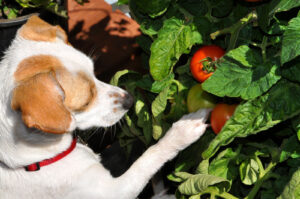 There are plenty of risks to your dog daily. Whether it be cars, other dogs, or something as simple as a plant, it is vital to know the risks that can affect your dog.
There are plenty of risks to your dog daily. Whether it be cars, other dogs, or something as simple as a plant, it is vital to know the risks that can affect your dog.
The most common poisonous plant to dogs is the Sago Palm. This plant is very popular in warmer climates. Every part of this plant is toxic to dogs. This plant is extra dangerous because some dogs find them very delicious and are very attracted to them. The serious side effects of this plant include liver failure and death in some cases.
Another common plant that is toxic to dogs is the tomato plant. When dogs consume this, it can cause weakness, gastrointestinal problems, dilated pupils, slow heart rate, drowsiness, and confusion. Make sure your dog steers clear of this plant to avoid any unnecessary vet visits.
Aloe vera is another summertime plant that is toxic to dogs. The saponins in this succulent can cause vomiting, diarrhea, lethargy, tremors, and general nervous system depression.
Ivy is also quite toxic to dogs, having the capability of causing diarrhea, vomiting, excessive salivation and drooling, and abdominal pain.
The amaryllis bulb is a popular garden ornamental but is poisonous to dogs. Be sure to pay attention to the bulbs if you grow them inside. Similarly, the gladiola flower can cause drooling, vomiting, diarrhea, and lethargy when consumed.
The holly shrub is a low toxicity plant, but your dog could still experience vomiting and diarrhea if eaten.
The daffodil, commonly found in the spring, can cause intestinal spasms, low blood pressure, salivation, tremors, vomiting, diarrhea, and even cardiac arrhythmia if eaten by your dog.
Common in every flower arrangement is the baby’s breath flower. When eaten, this small flower can cause vomiting and diarrhea.
Used to attract butterflies, milkweed is very common and pleasant to look at. However, this flower will induce vomiting and diarrhea, difficulty breathing, rapid and weak pulse, dilated pupils, and even more serious issues such as kidney or liver failure and death.
Common in parks and other large-scale landscaping, the castor bean can cause drooling, vomiting, diarrhea, extreme thirst, loss of appetite, and abdominal pain. It is potentially fatal in severe cases which may present as muscle twitching, tremors, seizures, and even coma.
The azalea or rhododendron flower is poisonous to dogs and produces serious gastrointestinal issues. Additionally, it can cause weakness, discoordination, and weak heart rate. This flower has the potential to be fatal.
Next, the tulip is very popular for gardens but can cause gastrointestinal issues as well as central nervous system depression and even convulsions and death.
Similarly, the chrysanthemum flower can cause vomiting, diarrhea, skin rash, and drooling for your dog if they consume it.
Lastly, the begonia is an extremely common garden flower that is toxic to your dog. It can cause extreme oral irritation and excessive inflammation of the mouth and drooling and vomiting.
Summertime is the time to be outdoors, but that means an increased risk for your pet to accidentally consume something poisonous to them. Be sure to keep an eye on your dog and monitor what they try to eat. If you have any questions or concerns about your pet has, or may have, eaten, contact us today!
Dr. Olsen’s Breed Spotlight: The Peterbald Cat

The Peterbald cat is a loyal and affectionate feline, known for being “dog-like”. They are very friendly, playful, energetic, and smart. The Peterbald is a descendent of the Don Sphynx cat, still bearing some of its qualities like its varying amount of fur, dexterous front paws, big ears, and wrinkly skin. The other feline in a Peterbald cat is the Oriental Shorthair cat. The Peterbald still carries its long and lithe body shape and oblong head shape from them. However, unique to a Peterbald is their long front toes with webbing. It allows them to hold and manipulate toys, unlike many other cats.
The Peterbald’s fur varies from a velvety, fuzzy fur to a completely hairless cat. There is even a type that doesn’t even have whiskers or eyebrows, making their skin feel sticky to the touch. Also interesting is that Peterbald’s fur changes throughout their life. This means that if a Peterbald has one of these coats at birth, it can change significantly during their first two years of life, and the hair can be altered, gained, or lost.
The care of Peterbald cats varies based on their coat. If they have a thin fur coat or no hair at all, they require weekly bathing and wipe downs to keep their skin free of harmful oils. Since Peterbald cats can have very thin coats, they need to be kept as inside cats. Moreover, many Peterbald cats can sunburn, have sensitivity to extreme temperatures, and can be easily injured when playing with other cats or children. But given proper care, these cats are relatively low maintenance and have very few associated breed-health issues.
If you are looking to adopt a Peterbald, know that these cats are still somewhat rare, so acquiring one is not an easy feat. Be sure to check with animal shelters, rescue groups, and reputable breeders to see if a Peterbald is needing a forever home. Since they are often not readily available, it can be difficult to find a Peterbald kitten. Important to note is that hairless cats are often sold for higher prices.
If you have any questions, feel free to contact Dr. Olsen at Olsen Veterinary Clinic at 618-656-5868!
Tips For Socializing Your Dog
 Socializing your dog teaches them how to react to the world around them healthily without any unnecessary fear or aggression. It is important to start socialization early, so it becomes their normal behavior. Ideally, it should be between three and 12 weeks of age, but not everyone is with their furry friend at that point in their life. Beyond 18 weeks, socialization gets a lot harder, but it is not impossible.
Socializing your dog teaches them how to react to the world around them healthily without any unnecessary fear or aggression. It is important to start socialization early, so it becomes their normal behavior. Ideally, it should be between three and 12 weeks of age, but not everyone is with their furry friend at that point in their life. Beyond 18 weeks, socialization gets a lot harder, but it is not impossible.
An important first step is to take your dog out on daily walks in public. This allows your dog to be exposed to many different experiences such as cars, other dogs, and strangers. The world becomes less scary after a few trips outside. Keep them on a short leash and take your dog on different routes to expose them to new sights and smells. Typically, new puppies should be exposed to different places, bodies of water, woods, beaches, and common neighborhood objects like street signs, bikes, strollers, skateboards, and benches.
Related, expose your dog to a wide variety of people such as men, women, and children so that they can get acclimated to the idea of people other than its owners. If your dog isn’t exposed to people other than its owners, it could become wary of anyone who isn’t their owner, so it is crucial to diversify whom your dog interacts with. Included in socialization is allowing your dog to meet unfamiliar people in unfamiliar clothes like hoods, jackets, sunglasses, and hats.
If your dog acts scared, stay calm and confident. Don’t push them, but don’t make a big deal out of their scared behavior. Use treats to give your dog a positive association with new people and experiences.
Socializing your dog allows them to enjoy the world around them and new experiences. To help your dog not fear new surroundings and people, start early, and show them all that your area has to offer! If you have any questions, feel free to contact Dr. Olsen at Olsen Veterinary Clinic at 618-656-5868.
